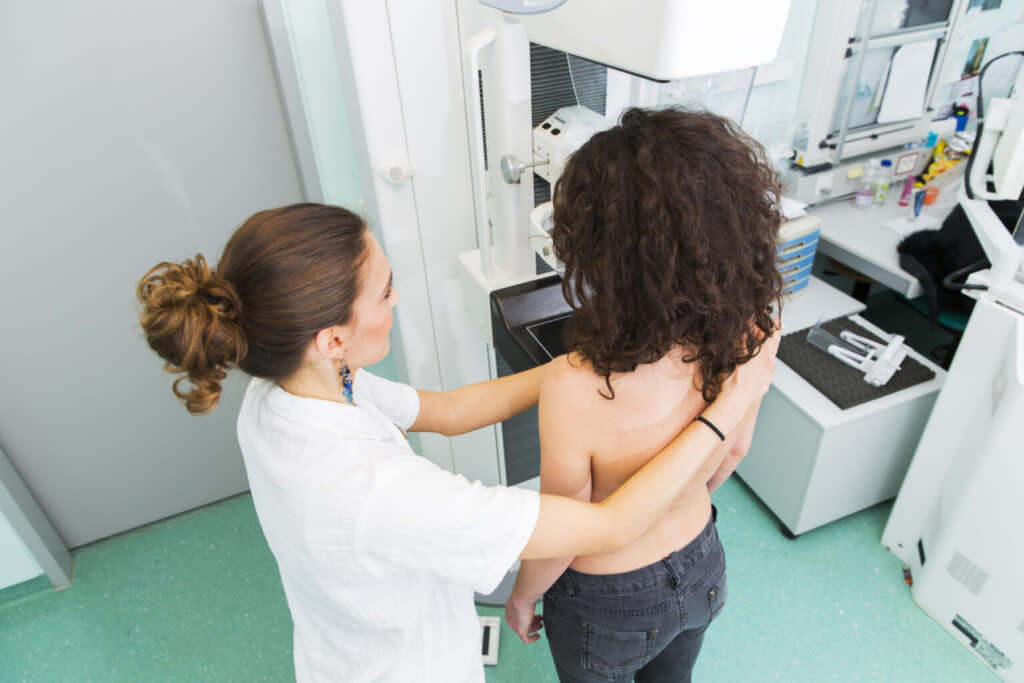Researchers have updated recommendations for breast cancer screenings

A nurse stands beside a women having a mammogram to screen for breast cancer. There are new recommendations for when to receive such screenings. (Getty Images)
Breast cancer is the most commonly diagnosed cancer and the leading cause of cancer deaths among women worldwide. Rates for breast cancer are higher in Western countries compared with Asia and Africa.
Prevention and screening are two of the most effective ways to tackle diseases.
Preventive measures for breast cancer and several other cancer types include cessation of smoking, quitting or cutting down on alcohol, avoiding processed food and red meat, eating plenty of fruits and vegetables, and engaging in regular exercise.
Screening can detect cancers early, when they are easier to treat. The most common forms of screening include a clinical breast exam and a mammogram. In a breast exam, a physician or a nurse checks for lumps by hand. Mammograms are X-ray pictures of the breast that allow doctors to look for early signs of cancer. Additional screening tests include MRIs, which use radio waves and magnets to create an image of the breast.
Screening guidelines in the U.S. have changed since 2021. The U.S. Preventive Services Task Force, composed of independent medical experts, now recommends mammograms every other year for women with average cancer risk at age 40 instead of 50.
American Cancer Society screening guidelines recommend annual mammograms for women ages 45-54, while women beyond 55 can choose to have an annual or a biennial mammogram.
These recommendations would apply to all people assigned female at birth with average risk of breast cancer, and those with a family history of breast cancer or with dense breasts.
For those who have or had breast cancer, have mutations in BRCA1 and BRCA2 breast cancer repair genes, have received high-dose radiation therapy to the chest, or have had breast lesions, it is recommended they follow the advice of their physicians.
Medical experts now urge that individuals be asked about their medical history, because a family history can increase their risks for certain cancers. Risks for breast cancer in women include age, having a first-degree relative with breast cancer or having a dense breast. Women with average risk would be those that have a family history of cancer, a genetic mutation, or have not had chest radiation therapy before 30.
Screening should begin at an early age for high-risk individuals. For example, those with two first-degree relatives with breast cancer have a greater likelihood of being diagnosed with breast cancer than average.
What does it mean to have dense breast? Breast tissue comes in three types: glandular tissue or lobes synthesize and secrete milk; fibrous tissue supports and holds the other types; and fatty tissue fills the spaces between glands and fibrous tissue. When glandular and fibrous tissue exceeds a certain amount as compared with the amount of fatty tissue as seen on a mammogram, this is known as a dense breast.
Having a dense breast is considered a slight risk factor, similar in risk to having an aunt with the disease. Since a tumor can hide within glandular and fibrous tissues that make up the dense areas that appear white in a mammogram, a dense breast on a mammogram can be worrisome. Some cancer specialists believe that women with high risk factors should start annual MRI screening as well.
As for additional screenings, Joan Elmore and Christopher Lee, at UCLA and University of Washington, Seattle, respectively, want more evidence before cancer screening facilities in the U.S. will begin to inform women about their breast densities.
Should women with dense breasts — about half of all women in the United State — require additional screenings such as an ultrasound or MRI? Once the biological mechanisms for an association between dense breasts and cancer are better elucidated, or biomarkers are found that could predict the risk for cancer in women with dense breasts, we will have better answers.
Larger studies are definitely needed before artificial intelligence is introduced to assist with mammography. Large population studies have shown that computer-aided mammograms were not necessarily accurate as originally thought.
While disparities in cancer incidence and deaths from breast cancer persist and more progress needs to be made, health care policies should focus more on health education and prevention so that we have fewer patients needing expensive treatments.
Syed Jamal teachers college-level chemistry, biology and anatomy/physiology and researches phytoremediation and cancer biology. Through its opinion section, Kansas Reflector works to amplify the voices of people who are affected by public policies or excluded from public debate. Find information, including how to submit your own commentary, here.
The post Researchers have updated recommendations for breast cancer screenings appeared first on Kansas Reflector.

